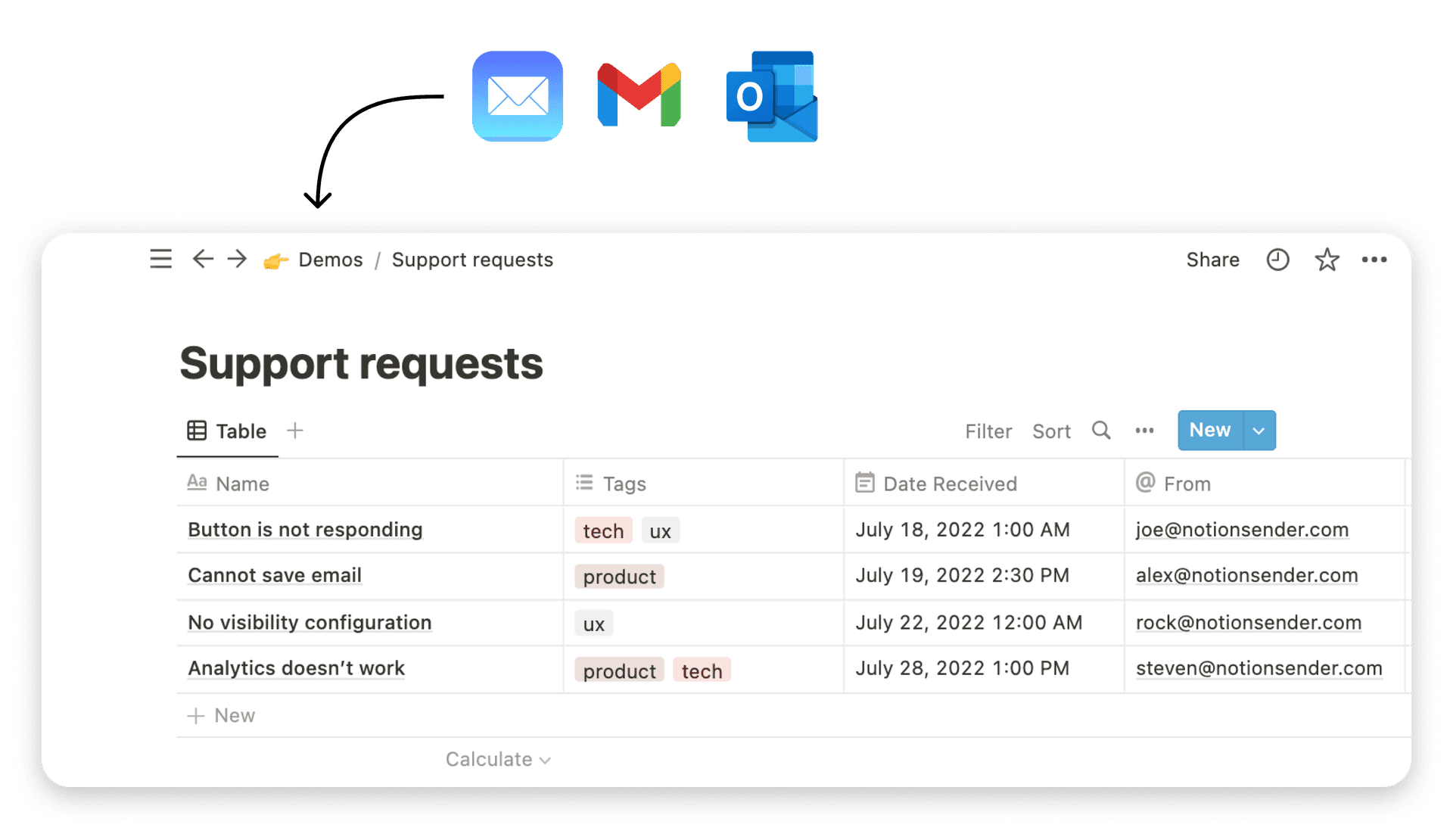12 Best Productivity Tools for Freelancers in 2025

Juggling clients, projects, invoices, and your own sanity is the daily reality of freelancing. The right digital toolkit isn't a luxury; it's the fundamental operating system for a scalable, profitable, and less stressful business. When you're the CEO, accountant, project manager, and lead creative all at once, efficiency isn't just a goal, it's a survival mechanism. This is where the strategic implementation of productivity tools for freelancers becomes a game-changer, automating administrative burdens and freeing up your cognitive energy for high-value work.
This comprehensive guide moves beyond generic feature lists to provide a deep dive into the most effective platforms available today. We'll cut through the marketing hype to deliver a practical analysis of 12 essential tools that solve the core challenges of freelance life: from project management and time tracking to invoicing and client communication. Our goal is to help you build a cohesive productivity system that works as hard as you do, transforming scattered to-do lists and overflowing inboxes into a streamlined, automated workflow.
Inside, you'll find a detailed breakdown of each tool, complete with specific use cases, an honest assessment of limitations, and actionable advice for seamless integration into your current processes. We’ve included screenshots for visual context and direct links to get you started immediately. Forget sifting through dozens of surface-level reviews. This resource is your definitive roadmap to selecting the right productivity tools for freelancers, reclaiming your time, and focusing on the creative and strategic work that truly drives your business forward. Let's get started.
1. NotionSender
NotionSender stands out as a premier productivity tool for freelancers who live and breathe inside Notion. It fundamentally transforms your workspace by embedding a powerful email client directly into your existing databases, eliminating the disruptive need to switch between your project management hub and your inbox. This seamless integration allows you to centralize all client communication, project updates, and invoicing right where the work happens.
For freelancers, this consolidation is a game-changer. Imagine a client replies to an invoice; instead of digging through your inbox, the email, complete with its attachment, automatically populates your Notion finance tracker. This is achieved by assigning a unique email address to each database, creating a powerful, automated funnel for incoming communication.
Why NotionSender Excels for Freelancers
What elevates NotionSender is its AI-driven intelligence and robust outbound capabilities. The AI-powered smart data extraction can automatically read an incoming email and populate Notion properties like "Client Name," "Due Date," or "Project Status." This automation saves significant administrative time, reduces manual error, and keeps your project boards impeccably organized.
Furthermore, its no-code setup is incredibly intuitive, taking less than a minute to get started. You can leverage dynamic templates with personalized variables to send proposals, follow-ups, and project reports directly from Notion, maintaining brand consistency and efficiency.
Key Takeaway: NotionSender's core strength lies in its ability to unify communication and project management into a single, automated workflow, making it an indispensable asset for freelancers seeking to streamline operations.
Practical Use Cases
- Client Relationship Management (CRM): Create a client database in Notion and use NotionSender to log every email exchange automatically.
- Invoice Tracking: Forward invoices and payment confirmations to your dedicated "Finances" database email to capture details and attachments.
- Content Approval Workflows: Send content drafts to clients from your "Content Calendar" and have their feedback emails land directly on the relevant project card.
Key Features and Considerations
| Feature | Details & Impact for Freelancers |
|---|---|
| Unique Database Emails | Assigns a dedicated email address to any Notion database for automated capture. |
| AI Data Extraction | Intelligently summarizes emails and fills Notion properties, saving hours of manual data entry. |
| Dynamic Email Sending | Send personalized emails using Notion properties as variables; perfect for outreach and updates. |
| Scheduling & Automation | Plan your communications in advance by scheduling emails to be sent at a later time. |
| Pricing | A generous free plan is available. The premium plan is $19/month for advanced features like unlimited email addresses and AI extraction. |
While the 10MB attachment limit on the free plan is a consideration for those sending large design files, the platform's overall utility is immense. Its simplicity and power make it one of the most effective productivity tools for freelancers looking to optimize their Notion-based workflows. For those interested in its technical capabilities, you can explore the NotionSender API documentation.
Website: https://www.notionsender.com
2. Notion
Notion positions itself as the all-in-one workspace, a bold claim it largely lives up to for freelancers seeking to consolidate their digital tool stack. It uniquely combines documents, databases, task managers, and wikis into a single, highly flexible environment. This adaptability makes it one of the most powerful productivity tools for freelancers who need to manage diverse project types, from simple content calendars to complex client relationship management (CRM) systems, all without switching apps.
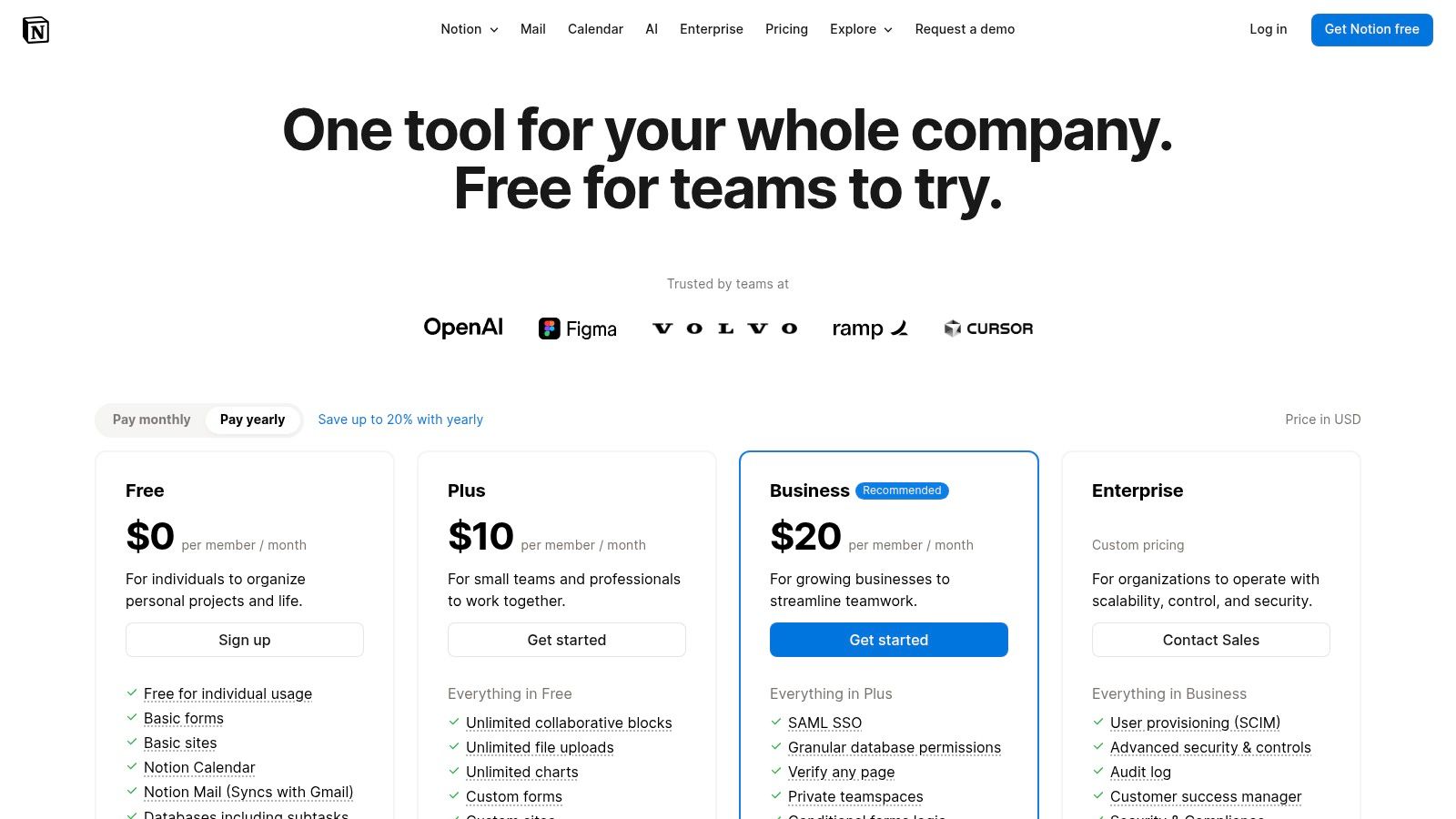
Unlike dedicated task managers, Notion's strength lies in its interconnected database system. You can create a master task list, a client database, and a project tracker, then link them together to see how tasks relate to specific clients or project milestones. This creates a centralized "second brain" for your entire freelance business. Recently, the addition of Notion AI enhances this by allowing you to summarize meeting notes, draft emails, or research topics directly within your workspace.
Key Considerations
Pricing: Notion offers a generous Free plan for individuals, which is often sufficient for solo freelancers. The Plus plan ($8 per user/month, billed annually) adds features like a 30-day page history and larger file uploads, while the Business plan ($15 per user/month, billed annually) includes advanced security features.
Best Use Case: Ideal for freelancers who want to build a custom, centralized hub for project management, client data, and internal documentation (SOPs). It excels when you need to provide clients with a polished, easy-to-access project portal.
Limitations: The platform's immense flexibility can be its biggest drawback. It requires a significant upfront investment of time to structure your workspace effectively. Without a clear plan, it can quickly become disorganized. To avoid this, it's helpful to start with a template or review best practices; for more guidance, check out these 10 tips to get the most out of Notion.
3. Trello
Trello champions a simple, visual approach to project management, making it one of the most accessible productivity tools for freelancers. Its core strength lies in its Kanban-style boards, which allow you to track tasks through various stages of a workflow, from "To-Do" to "In Progress" to "Complete." This intuitive drag-and-drop interface is perfect for managing content pipelines, client onboarding processes, or sales funnels without the complexity of more robust project management suites.
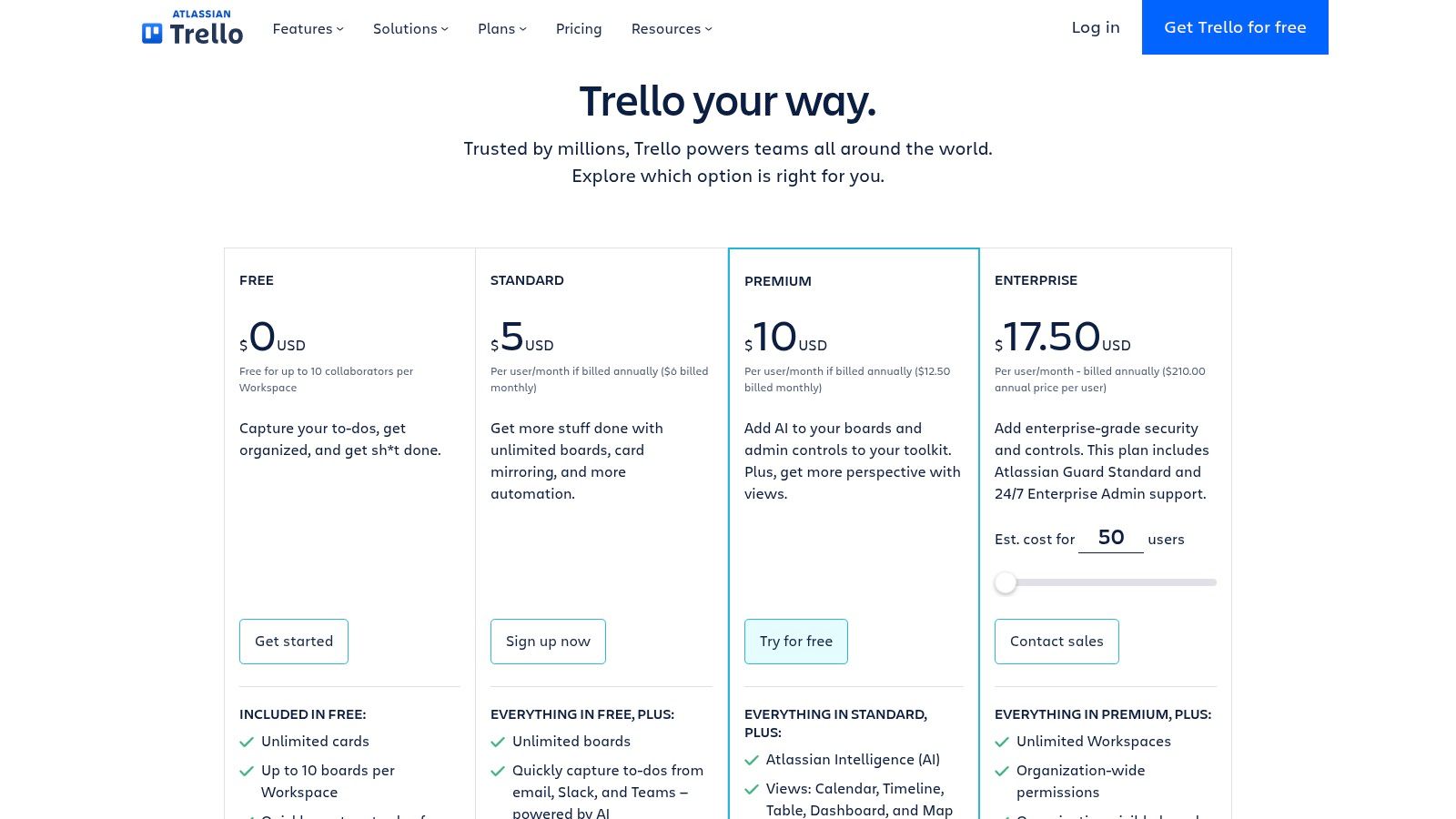
Unlike more complex systems, Trello's power is in its straightforwardness. Each task is a "card" that can hold checklists, due dates, attachments, and comments. This keeps all relevant information contained in one place. For freelancers, this means you can easily invite clients to a specific board to track project progress, fostering transparency without overwhelming them with a complicated system. The built-in automation tool, Butler, further enhances productivity by handling repetitive tasks like moving cards or adding checklists automatically.
Key Considerations
Pricing: Trello offers a robust Free plan with up to 10 boards per workspace, which is excellent for individual freelancers. The Standard plan ($5 per user/month, billed annually) unlocks unlimited boards and advanced checklists. The Premium plan ($10 per user/month, billed annually) adds multiple project views like Calendar and Timeline, which are crucial for managing more complex schedules.
Best Use Case: Excellent for freelancers who need a visual, easy-to-use task manager for specific projects or workflows. It is particularly effective for managing content calendars, tracking client deliverables, and collaborating with clients who prefer a simple interface.
Limitations: While its simplicity is a benefit, it can be a drawback for those needing advanced features. Trello lacks native time tracking, in-depth reporting, or resource management capabilities found in comprehensive project management software. Many advanced features, known as "Power-Ups," and alternative views are locked behind paid tiers, which can feel restrictive on the free plan.
4. Todoist
Todoist excels at one thing: fast, simple, and reliable task management. While other productivity tools for freelancers aim to be all-in-one solutions, Todoist focuses on being an exceptionally good to-do list, making it perfect for freelancers who need to quickly capture ideas and organize their daily and weekly schedules without friction. Its standout feature is its natural language processing; you can type “Send invoice to Client X every last Friday of the month” and the app will automatically create a recurring task with the correct due date.
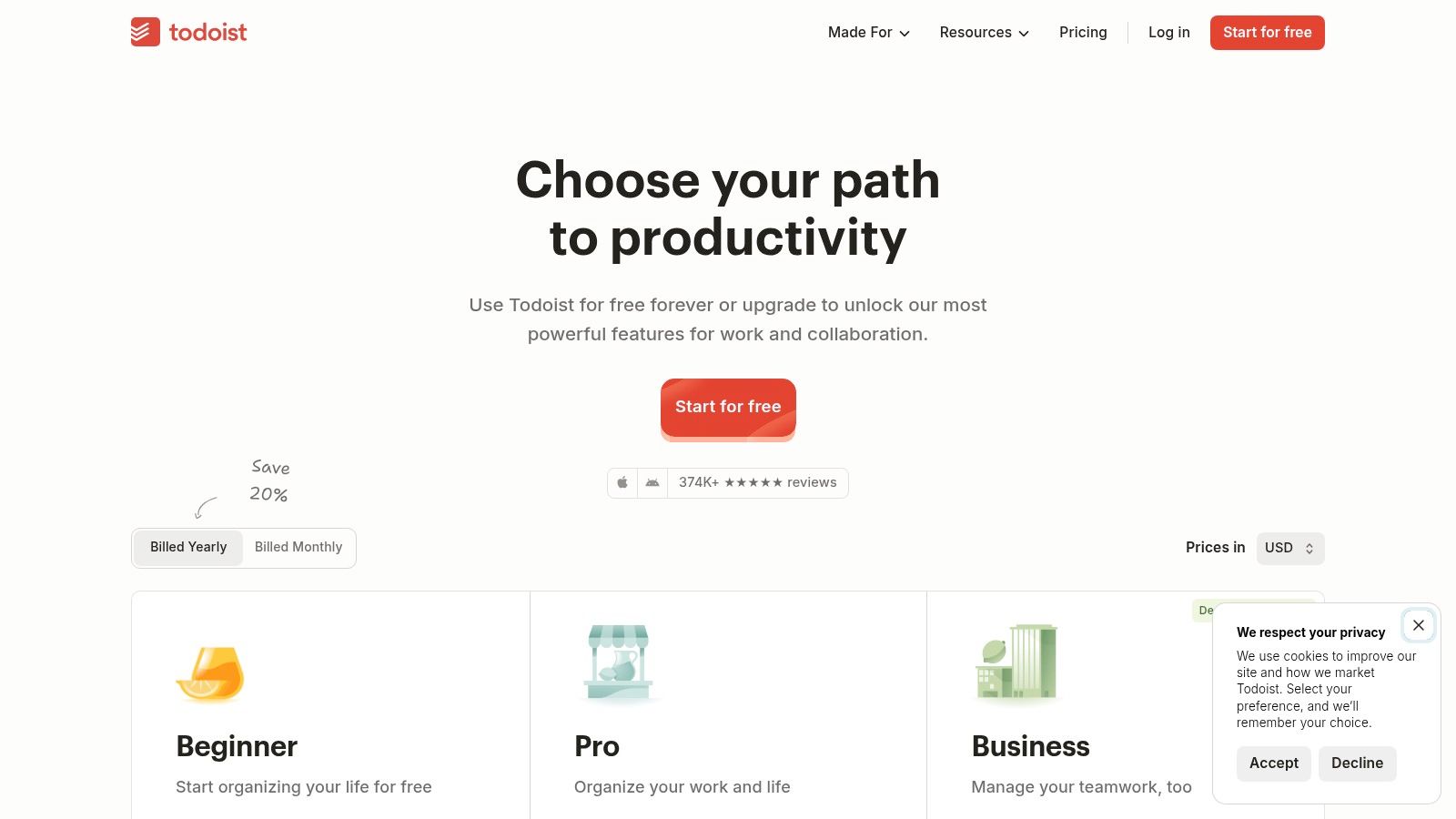
The platform’s cross-platform synchronization is nearly flawless, with excellent offline support ensuring you can manage your tasks from any device, anytime. Unlike more complex project management systems, Todoist is built for speed and clarity. You can organize tasks into projects (e.g., by client or service type), assign labels, and set priorities to create powerful, filtered views that show you exactly what you need to work on next. The recent addition of an AI Assistant helps break down large tasks into smaller, manageable steps, further streamlining your workflow.
Key Considerations
Pricing: The Free plan offers up to 5 personal projects and is a great starting point. The Pro plan ($4 per month, billed annually) is the sweet spot for freelancers, unlocking up to 300 projects, reminders, and a 25-year activity history. The Business plan ($6 per user/month, billed annually) adds team workspaces and centralized billing.
Best Use Case: Ideal for freelancers who need a dedicated, no-fuss task manager to organize their daily workload, track deadlines, and manage personal and professional to-dos in one place. It pairs well with other tools like Notion or a dedicated CRM.
Limitations: Todoist is not a comprehensive project management tool. It lacks advanced features like Gantt charts, robust time tracking, or complex task dependencies. While it supports basic collaboration, it is not designed to manage large, multi-person team projects, making it better suited for solo practitioners or very small teams.
5. Toggl Track
Toggl Track is the epitome of frictionless time tracking, designed for freelancers who need to accurately log hours without disrupting their workflow. Its core strength is simplicity: a one-click timer available across web, desktop, mobile, and browser extensions lets you start tracking time on any task instantly. This ease of use removes the barrier to consistent time logging, which is essential for accurate invoicing, project profitability analysis, and understanding your own productivity patterns.
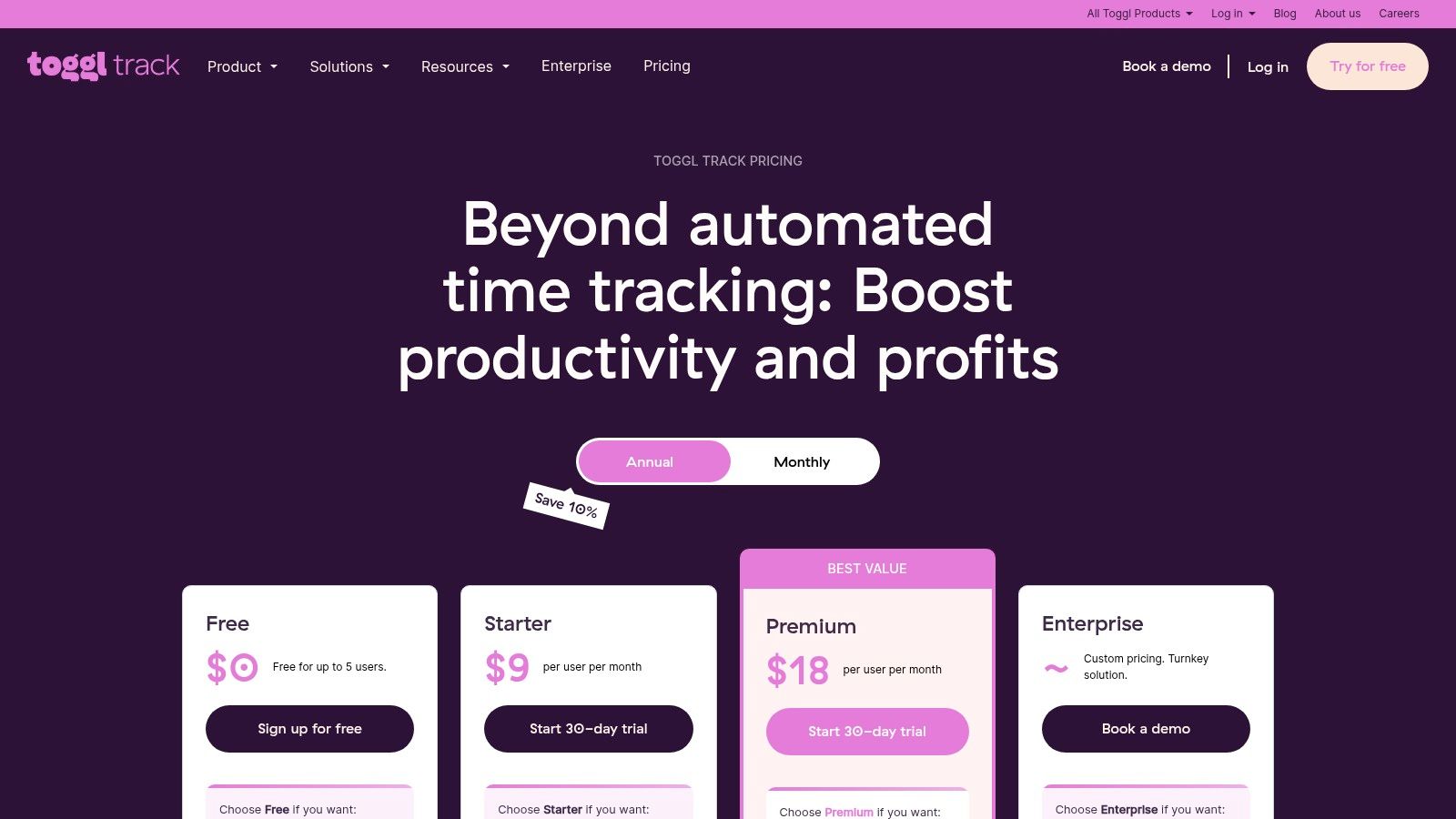
Beyond simple timing, Toggl Track provides powerful reporting that transforms raw data into actionable business insights. You can assign billable rates to projects, track costs, and generate professional, client-ready reports that clearly justify your invoices. Features like idle detection, calendar integrations that turn events into time entries, and a built-in Pomodoro timer make it one of the most versatile productivity tools for freelancers who bill by the hour or want to optimize their work sessions. It helps answer the critical question: "Where is my time actually going?"
Key Considerations
Pricing: Toggl Track offers a fantastic Free plan for up to 5 users, which includes unlimited time tracking, projects, and reporting. The Starter plan ($9 per user/month, billed annually) unlocks billable rates and task estimates, while the Premium plan ($18 per user/month, billed annually) adds project profitability charts and team management features.
Best Use Case: Perfect for freelancers who need dead-simple time tracking for hourly billing, retainer management, and improving personal time management. Its background operation and integrations make it easy to adopt and stick with.
Limitations: While it excels at tracking time and generating reports, Toggl Track is not an invoicing tool. You will need to export your data or integrate it with another platform like QuickBooks or Xero to create and send invoices. Some of the most valuable profitability analysis features are also reserved for the paid Premium plan.
6. Clockify
Clockify stands out in the crowded time-tracking market by offering a powerful, no-cost entry point for freelancers. It provides a straightforward solution for monitoring billable hours across unlimited projects and clients, which is a rare offering for a free tool. More than just a simple timer, it serves as a foundational productivity tool for freelancers who need to accurately gauge project profitability and justify invoices with detailed time reports.
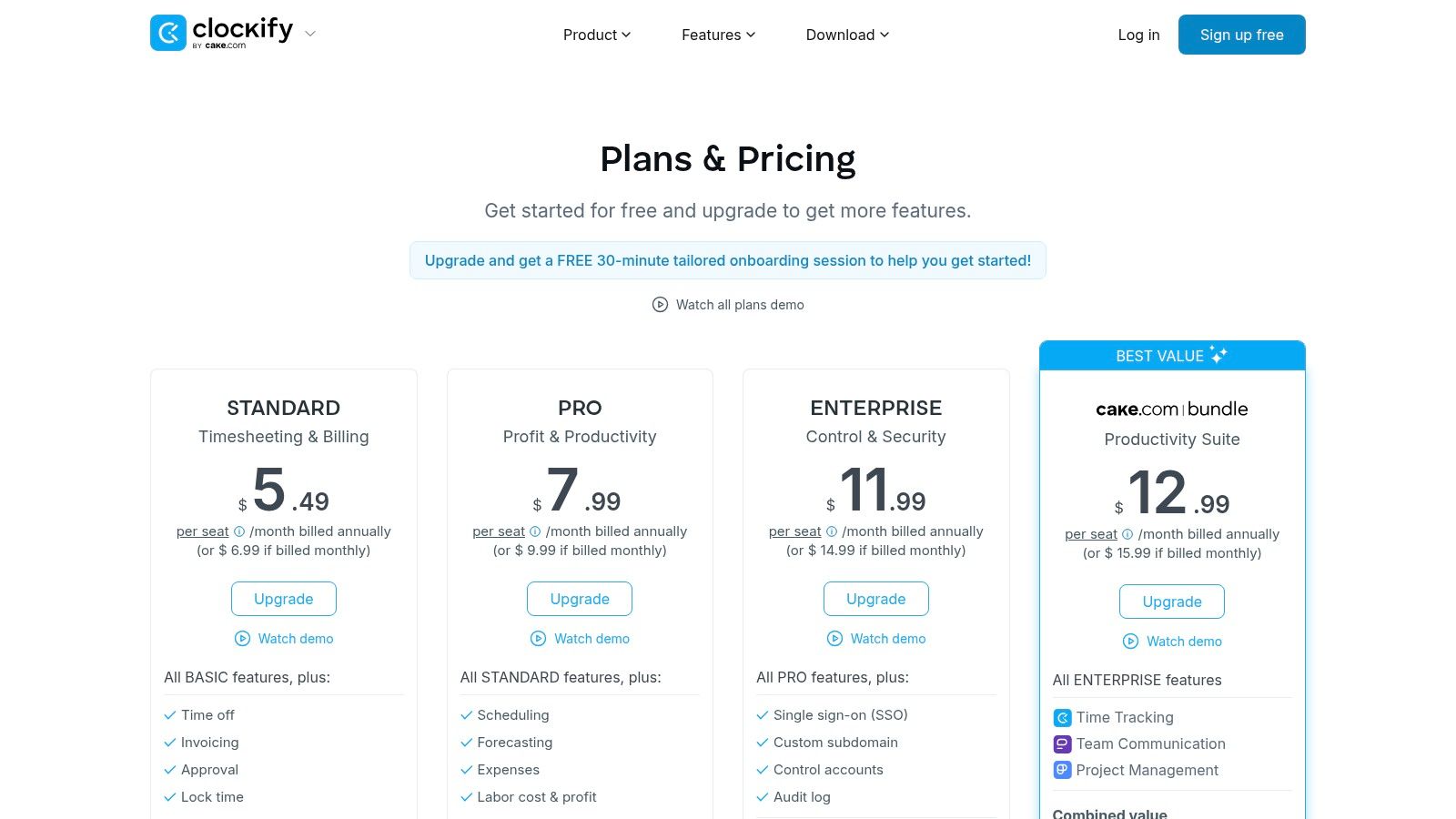
Unlike many competitors that gate essential features, Clockify’s free plan is robust enough for most solo professionals. Its core strength is its simplicity; you can start tracking time with a single click via its web app, desktop app, or browser extension. As your freelance business grows, its paid tiers integrate features like invoicing, expense tracking, and time-off management, allowing you to handle more administrative tasks directly within the platform. This scalability ensures the tool can evolve alongside your business needs.
Key Considerations
Pricing: The Free plan is incredibly generous and permanent. Paid plans start with the Basic plan ($3.99 per user/month, billed annually) for administration features, Standard ($5.49 per user/month, billed annually) for adding invoicing and timesheet approvals, and Pro ($7.99 per user/month, billed annually) for deeper profitability and forecasting analysis.
Best Use Case: Essential for any freelancer paid by the hour or working on fixed-price projects who needs to track time for accurate billing, project costing, and personal productivity analysis. It's particularly useful for those who need to provide clients with transparent, detailed timesheets.
Limitations: While highly functional, the user interface is less polished compared to more design-focused competitors. Some advanced features, like GPS tracking or scheduling, are spread across higher-tier plans, which might require careful plan selection if you need a specific capability beyond basic time tracking.
7. Calendly
Calendly tackles one of the biggest time-sinks for any freelancer: scheduling meetings. Instead of the endless back-and-forth of "what time works for you?", it automates the process entirely. You set your availability, share a professional booking link, and clients can instantly book a time that works for everyone, directly syncing with your connected calendar. This simple function makes it one of the most essential productivity tools for freelancers looking to reclaim their time and present a polished, professional front.
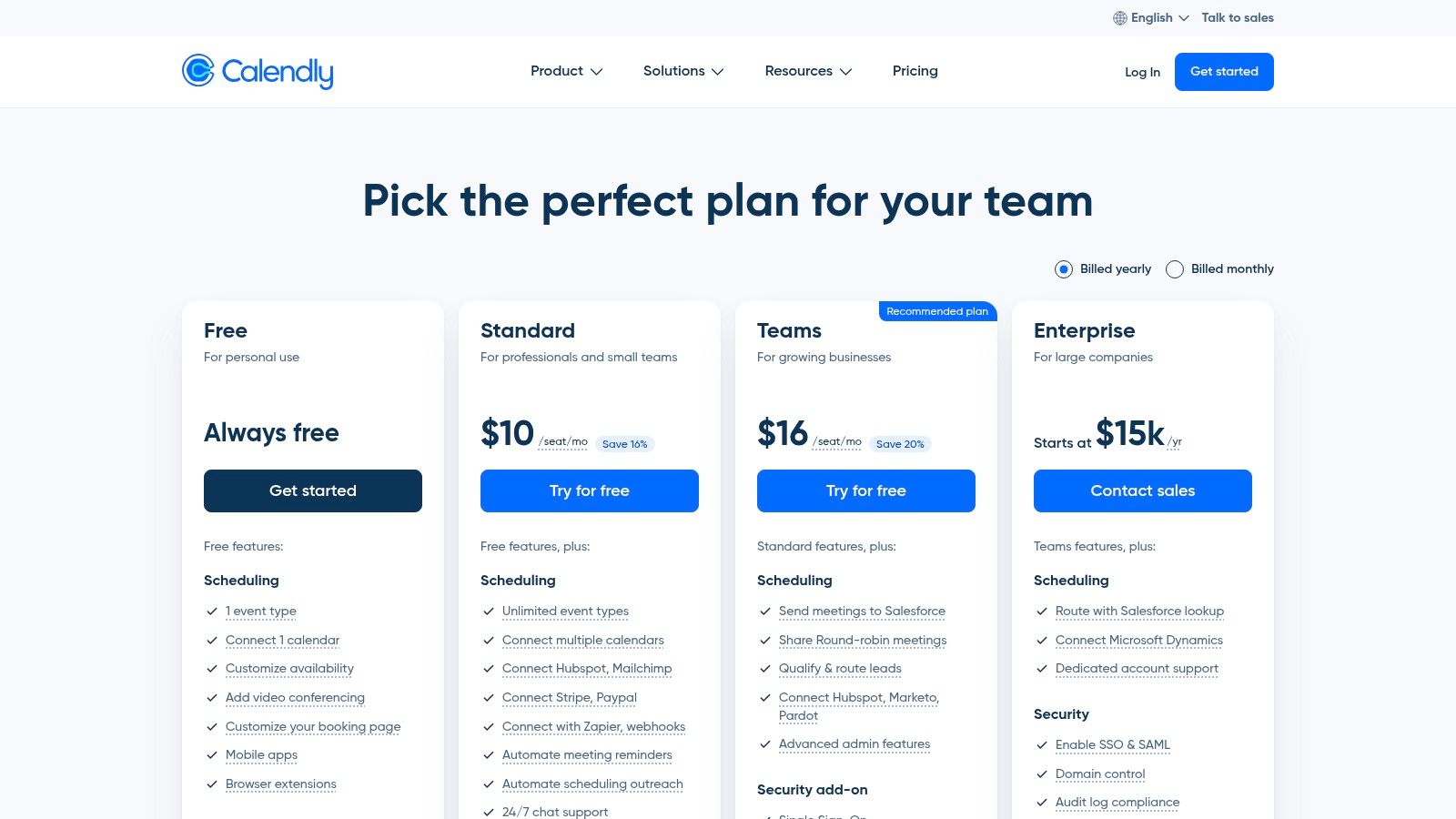
What sets Calendly apart is its focus on the entire meeting lifecycle. Using its "Workflows" feature, you can automate email or SMS reminders to reduce no-shows, send follow-up messages with resources, or even request feedback after a call. For freelancers who offer paid consultations, direct integrations with Stripe and PayPal allow you to collect payments at the time of booking, streamlining your invoicing process and ensuring you get paid for your time.
Key Considerations
Pricing: Calendly offers a powerful Free plan that includes one event type and unlimited scheduling, which is perfect for many solo freelancers. The Standard plan ($10 per user/month, billed annually) unlocks multiple event types and removes Calendly branding, while the Teams plan ($16 per user/month, billed annually) adds features like round-robin routing.
Best Use Case: Essential for service-based freelancers who frequently book discovery calls, client check-ins, or paid consulting sessions. It is a must-have for anyone looking to eliminate scheduling friction and project a highly professional image.
Limitations: While the free plan is excellent, more advanced customizations, like removing Calendly branding or creating complex automated workflows, require a paid subscription. The cost can also become a factor if you need to add team members, as pricing is on a per-seat basis.
8. Canva
For freelancers who aren't graphic designers, Canva is an indispensable productivity tool that democratizes visual content creation. It streamlines the production of everything from client proposals and presentations to social media graphics and brand assets. The platform replaces complex design software with an intuitive drag-and-drop interface, backed by an enormous library of templates, stock photos, and design elements. This allows freelancers to create professional, on-brand visuals in minutes, not hours, freeing up valuable time to focus on core client work.
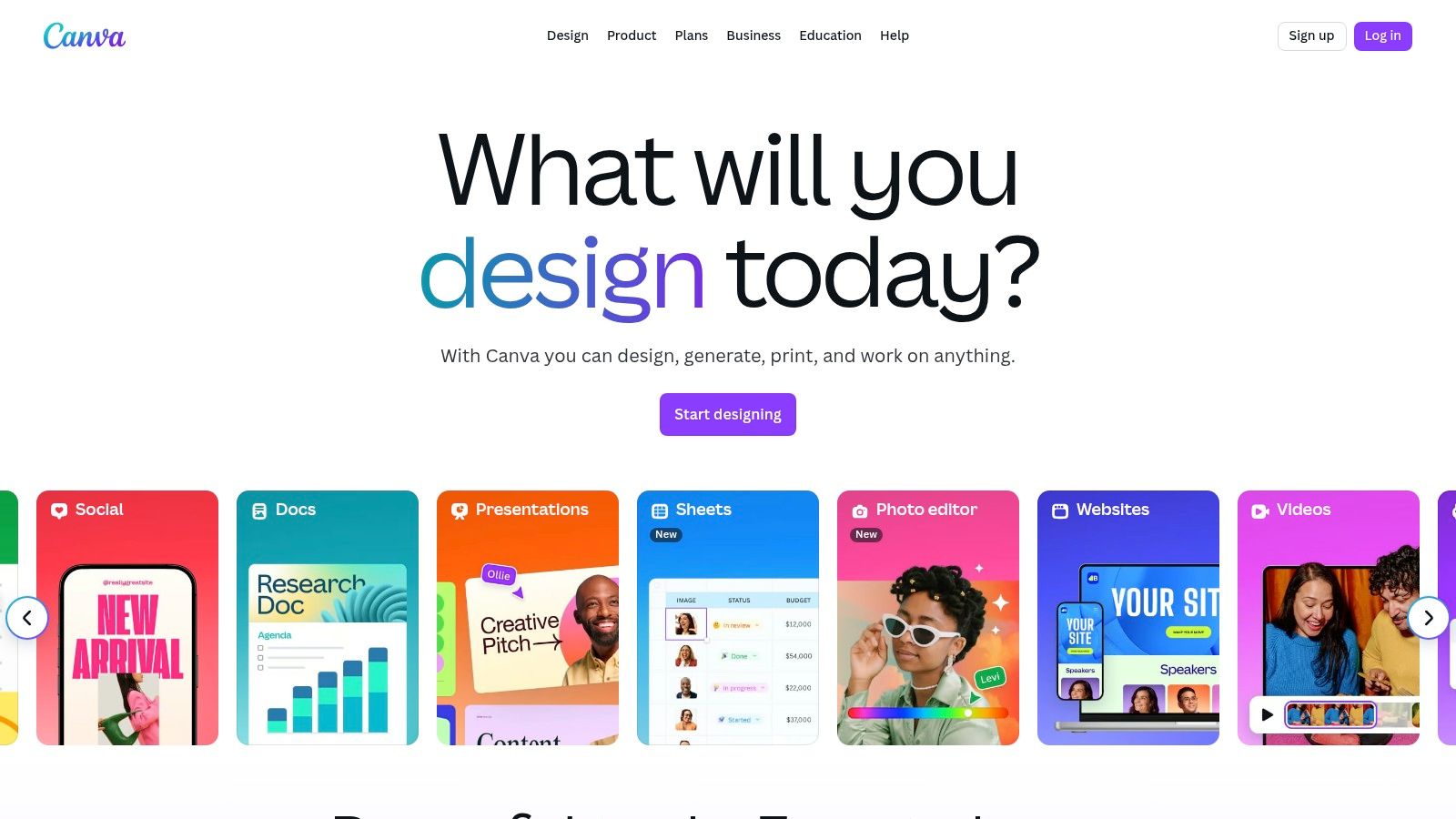
Canva's power for freelancers lies in its Brand Kit feature, which stores logos, color palettes, and fonts for instant access, ensuring brand consistency across all projects. The recent introduction of its AI-powered Magic Studio further boosts efficiency by generating text, creating images from prompts, and even translating designs into different languages. This combination of template-driven design and AI assistance makes it one of the most effective productivity tools for freelancers managing their own marketing or creating deliverables for clients.
Key Considerations
Pricing: Canva offers a robust Free plan with generous access to templates and assets. The Canva Pro plan ($119.99/year for one person) unlocks premium templates, the full Brand Kit, Magic Resize, and a larger content library. The Canva for Teams plan ($300/year for the first 5 people) adds collaboration features.
Best Use Case: Perfect for freelancers needing to quickly produce high-quality visual content for marketing, client proposals, or social media management without a design background. It is also excellent for creating reusable templates to standardize client-facing documents.
Limitations: While powerful, it isn't a substitute for professional design software like Adobe Illustrator for complex, bespoke vector work. Freelancers must also be careful to understand the licensing terms for stock media, especially when creating commercial work for clients, as some assets may have usage restrictions.
9. Zapier
Zapier is the essential glue for the modern freelancer's tech stack, an automation platform that connects thousands of different apps to eliminate repetitive administrative tasks. It empowers you to build "Zaps," which are simple, no-code workflows that trigger an action in one app based on an event in another. This makes it one of the most impactful productivity tools for freelancers, as it frees up valuable time spent on manual data entry, file transfers, and notifications.
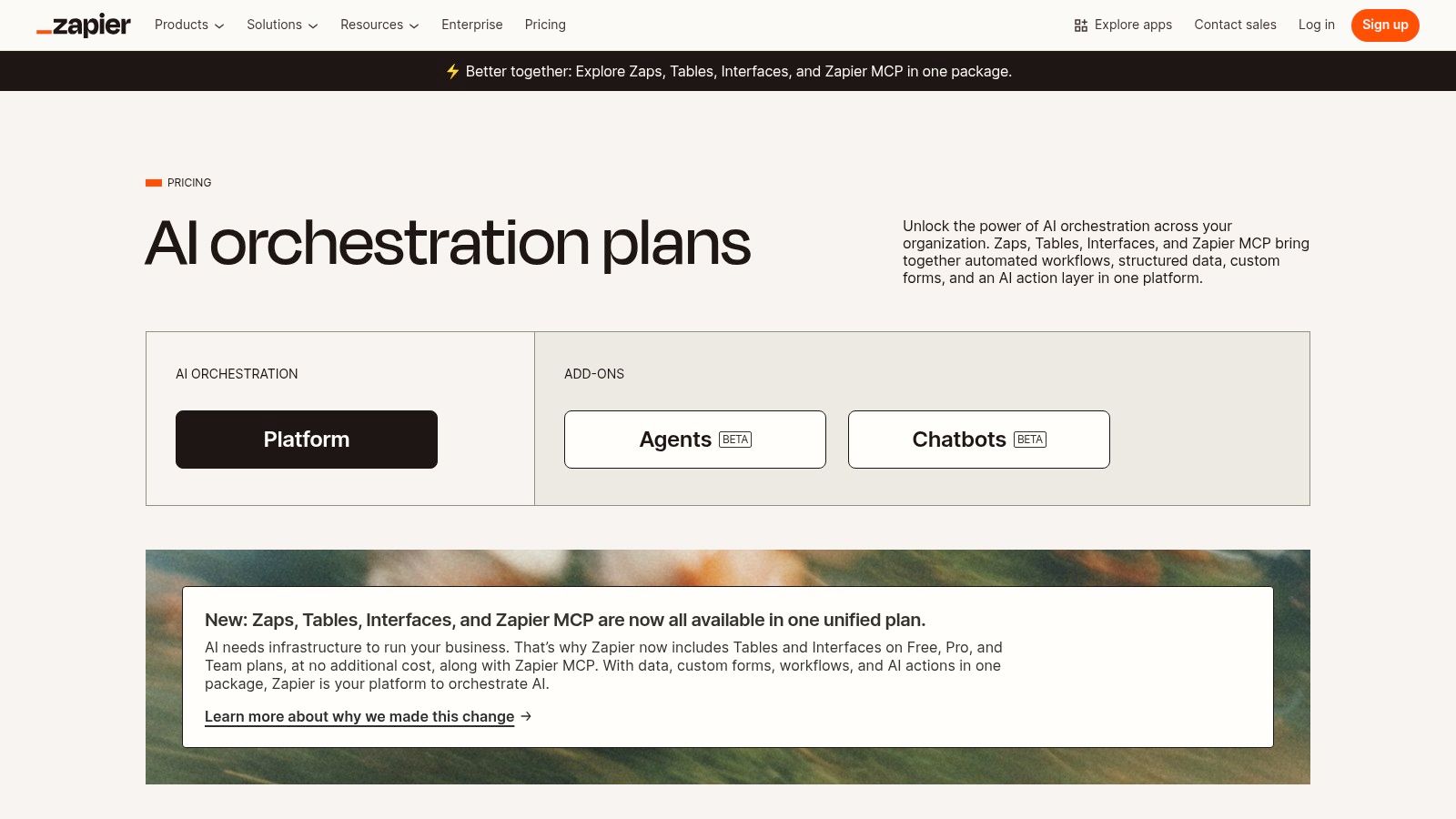
The platform's core strength is its massive ecosystem of over 8,000 integrations. You can automatically save new client email attachments from Gmail to a specific Google Drive folder, add new Stripe customers to your Mailchimp list, or create a Trello card from a new Typeform submission. Its visual, step-by-step editor makes creating these automations accessible even for non-technical users. For instance, automating email workflows can be a huge time-saver; for more ideas, explore these simple email management tips to boost productivity.
Key Considerations
Pricing: Zapier has a Free plan that allows for 100 tasks per month on single-step Zaps. Paid plans start with the Starter tier ($19.99/month, billed annually) for multi-step Zaps and 750 tasks, scaling up to the Professional plan ($49/month, billed annually) and beyond for higher task volumes and advanced features like custom logic with paths.
Best Use Case: Perfect for freelancers who use multiple, disconnected software tools and want to automate the handoffs between them. It’s ideal for streamlining lead capture, client onboarding, and financial administration without writing a single line of code.
Limitations: The cost can escalate quickly as your task usage increases, making it potentially expensive for high-volume operations. While simple Zaps are easy to create, debugging complex, multi-step workflows with conditional logic can become challenging and time-consuming if an error occurs.
10. Google Workspace
Google Workspace is the professional evolution of the free Google services many freelancers already use, bundling them into a cohesive and powerful business suite. Its core strength lies in its ubiquity and seamless integration; tools like Gmail, Calendar, Drive, Docs, and Meet are industry standards, ensuring near-universal compatibility with clients. For freelancers, this means a professional email address (@yourdomain.com), enhanced security, and centralized administration for all the essential productivity tools needed to run their business.
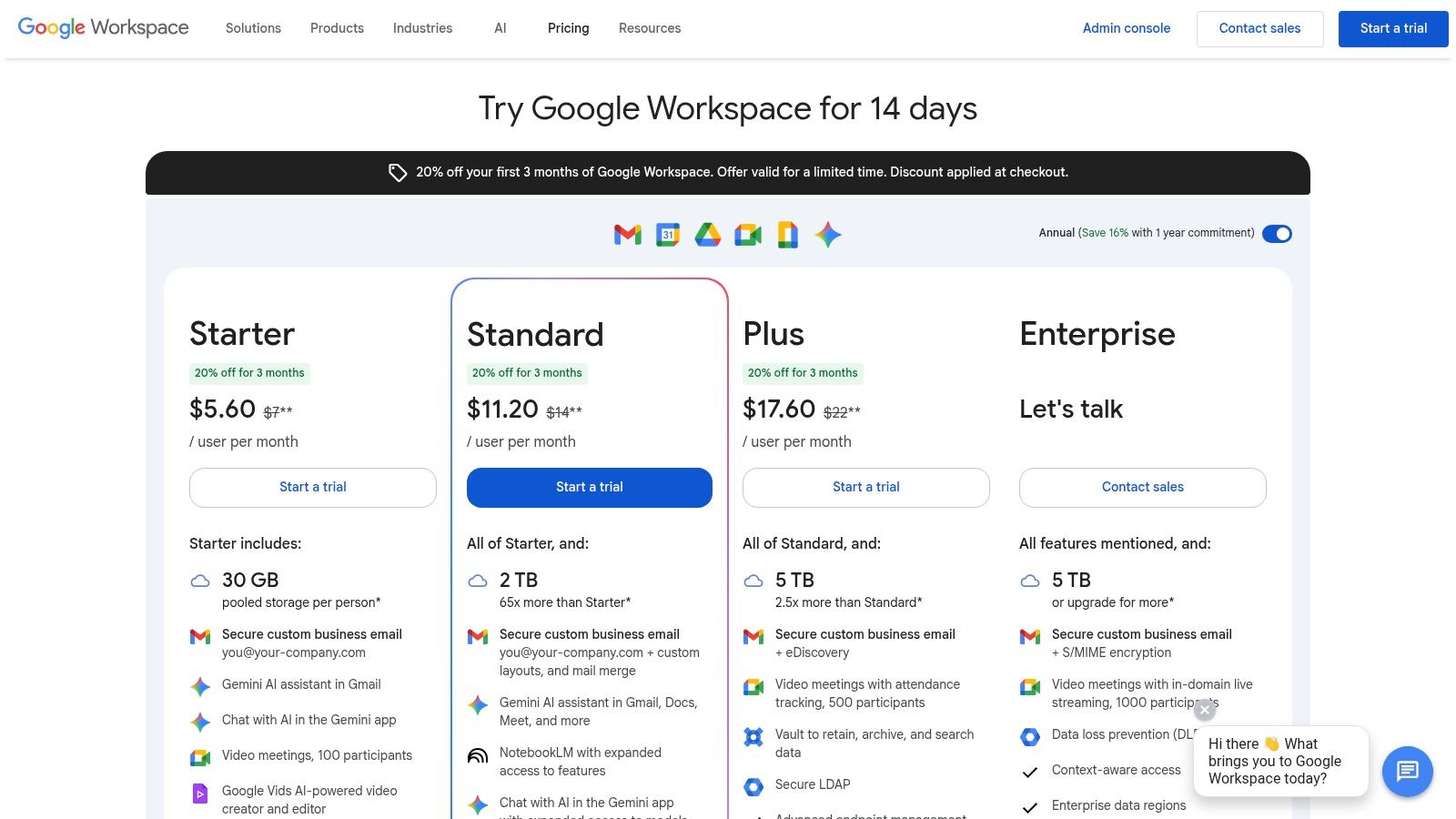
Unlike standalone apps, Workspace creates a frictionless environment where every tool works in concert. You can turn an email into a calendar event, collaborate on a Google Doc in real-time during a Google Meet call, and store all project files in a shared Team Drive. The recent integration of Gemini AI elevates this further, allowing you to draft proposals in Docs, summarize email threads in Gmail, or generate agendas directly from your calendar. This deep-level integration makes it one of the most efficient productivity tools for freelancers focused on client communication and collaborative document management.
Key Considerations
Pricing: The Business Starter plan is a cost-effective entry point at $6 per user/month, offering 30 GB of storage. The Business Standard plan ($12 per user/month) is a popular upgrade, providing 2 TB of pooled storage, appointment booking pages, and eSignature capabilities.
Best Use Case: Essential for any freelancer needing a professional email and a reliable, all-in-one suite for communication, file storage, and real-time collaboration. It’s the foundational digital office for freelancers who frequently co-create documents or presentations with clients.
Limitations: The primary drawback is the ongoing subscription cost, which can add up over time compared to one-off software purchases. While the storage is generous on higher tiers, heavy users like video editors may find the pooled storage on standard plans requires careful management or a more expensive upgrade.
11. FreshBooks
FreshBooks simplifies the often-dreaded financial side of freelancing, positioning itself as an accounting solution built specifically for service-based small businesses, not just accountants. It streamlines invoicing, expense tracking, and time management into one intuitive platform. This focus on user-friendliness makes it one of the most approachable productivity tools for freelancers who need to manage their finances without a steep learning curve or the complexity of enterprise-level software. It empowers you to create professional invoices, accept online payments, and track project profitability with ease.
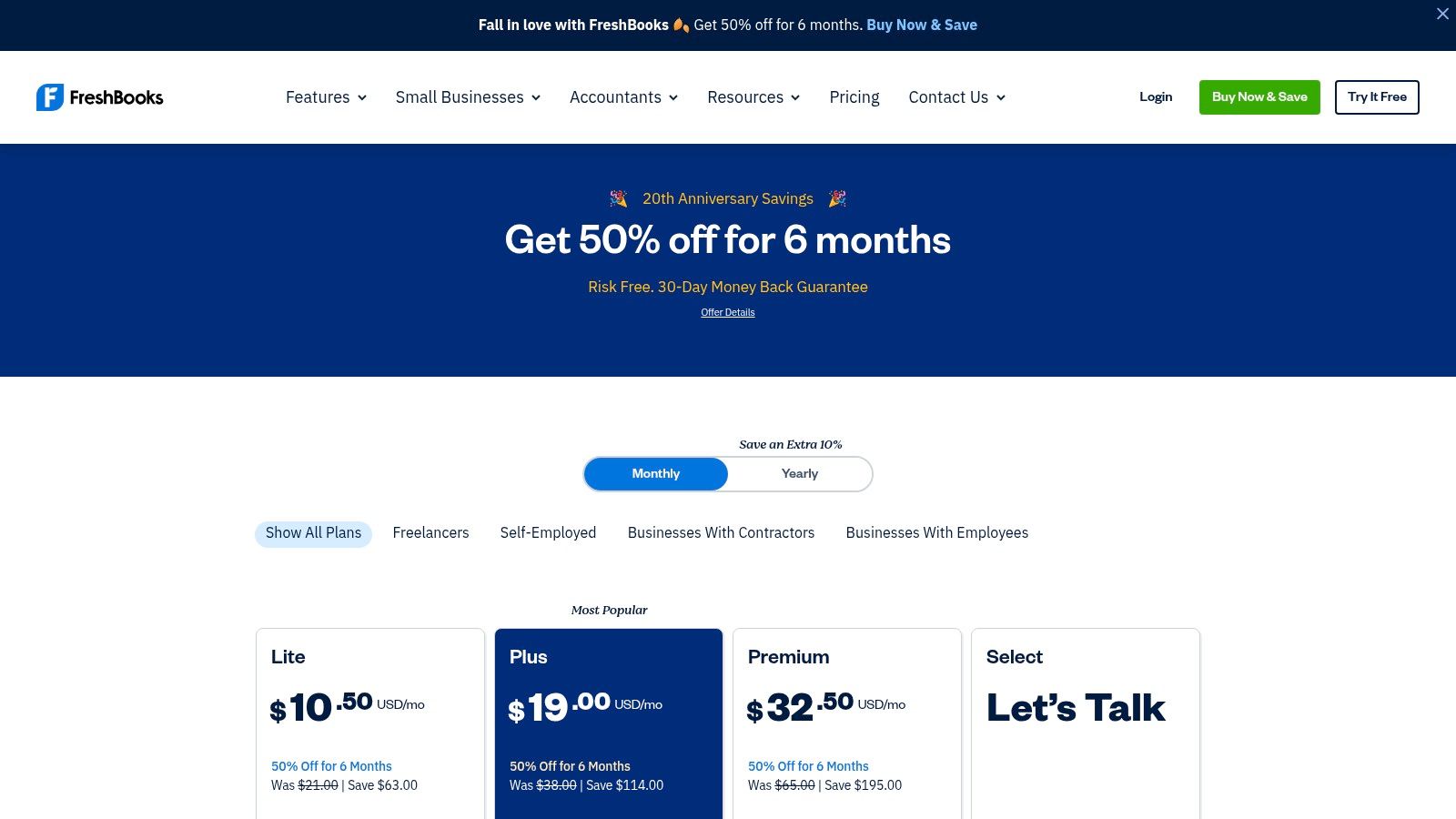
Unlike generic invoicing tools, FreshBooks integrates time tracking directly with project billing, ensuring every billable minute is captured and accounted for. You can generate detailed proposals that convert to invoices with a single click, automating a significant part of your client acquisition workflow. This seamless integration saves time and reduces the risk of manual errors, allowing you to focus more on client work and less on administrative overhead. For a deeper dive into managing your finances, FreshBooks can be complemented by understanding broader principles like accounting for contractors in the UK.
Key Considerations
Pricing: FreshBooks offers several tiers. The Lite plan ($19/month) is for basic needs with up to 5 billable clients. The Plus plan ($33/month) is the most popular, offering up to 50 clients and automated features. The Premium plan ($60/month) allows unlimited clients.
Best Use Case: Ideal for service-based freelancers, consultants, and agencies who need a simple yet powerful tool to manage invoicing, track time, and handle basic bookkeeping. Its client-facing features, like proposals and payment portals, are excellent for maintaining a professional image.
Limitations: The client limits on the lower-tier plans can be restrictive for freelancers with a large but varied client base. While excellent for core financial tasks, it lacks advanced inventory management or payroll features found in more comprehensive accounting suites like QuickBooks.
12. AppSumo
AppSumo isn't a single productivity tool but rather a curated marketplace that offers significant, often lifetime, deals on emerging software. For freelancers on a budget, it's an invaluable resource for acquiring powerful productivity tools, such as CRMs, schedulers, and project managers, at a fraction of their standard cost. The platform allows cost-conscious freelancers to build a robust tool stack without committing to recurring monthly subscriptions, which can dramatically reduce overhead.
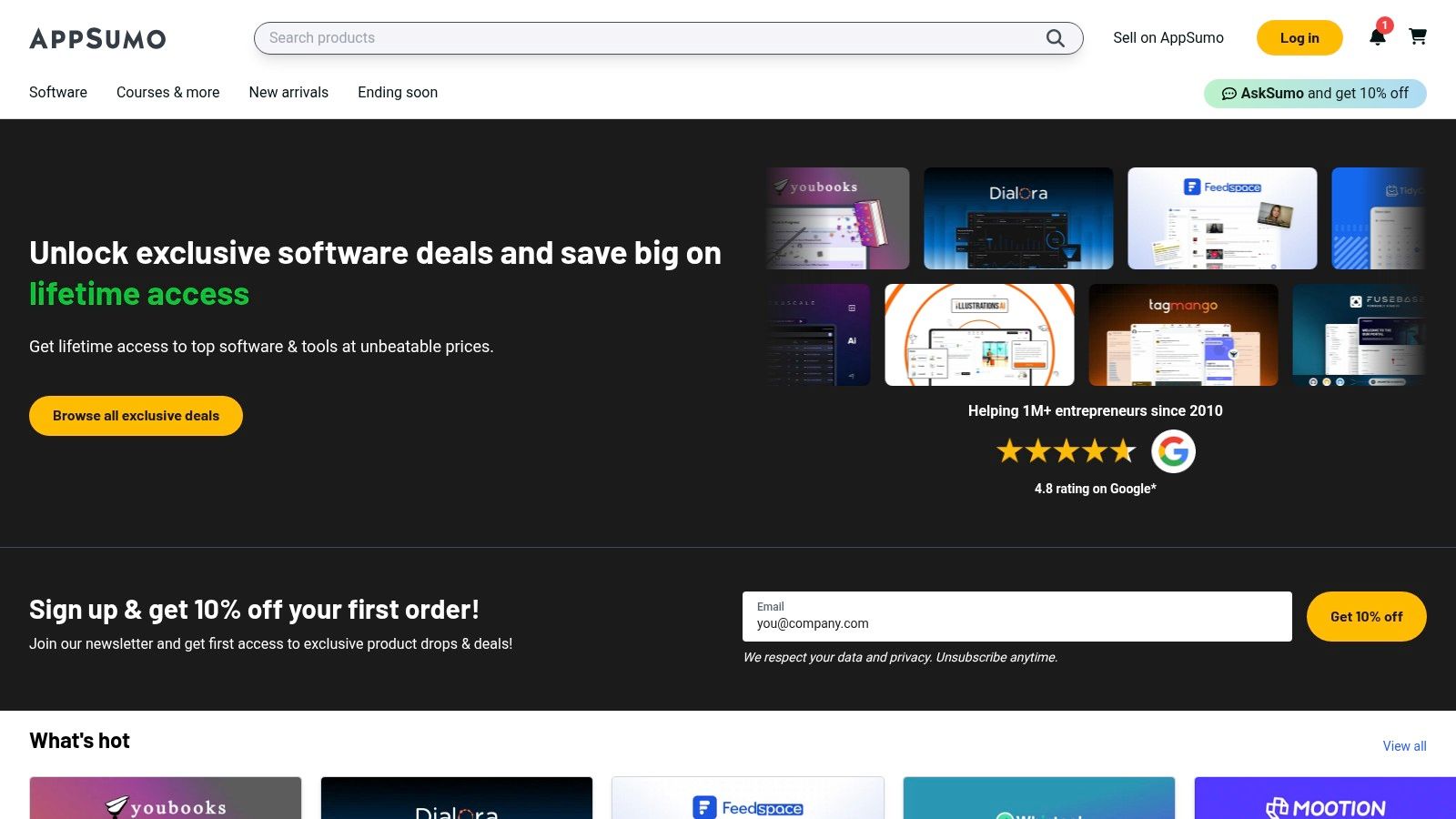
The primary appeal is the "lifetime deal" (LTD) model, where a one-time payment grants perpetual access to a tool. This makes it one of the best platforms for finding productivity tools for freelancers who are bootstrapping their business. While the deals are time-sensitive, the constant rotation of new software provides frequent opportunities to discover and test innovative applications that can streamline workflows, automate tasks, or enhance client communication.
Key Considerations
Pricing: Deals vary significantly, from $29 to several hundred dollars for lifetime access. There is no cost to browse the marketplace. The AppSumo Plus membership ($99/year) offers an extra 10% off purchases and other exclusive benefits. Most deals come with a generous 60-day money-back guarantee.
Best Use Case: Excellent for freelancers seeking to acquire new software for specific needs without long-term financial commitment. It's particularly useful for trying out up-and-coming tools that could become integral to your business operations before they become widely known and more expensive.
Limitations: The marketplace can be noisy, and finding high-quality, sustainable tools requires due diligence. Some startups featured may pivot or discontinue their products, so it's wise to read user reviews and research the vendor's history before purchasing. The time-sensitive nature of deals can also create a sense of urgency.
Productivity Tools Feature & Pricing Comparison
| Product | Core Features ✨ | User Experience ★ | Value & Pricing 💰 | Target Audience 👥 | Unique Selling Points 🏆 |
|---|---|---|---|---|---|
| NotionSender 🏆 | Email integration inside Notion, AI data extraction, templating & scheduling | ★★★★☆ Intuitive, no-code setup | Free plan + $19/mo premium unlocks advanced features | Small businesses, freelancers, project managers, marketers | Unique email per Notion DB, AI smart extraction, native Notion formatting |
| Notion | All-in-one workspace, real-time collaboration, AI-supported notes | ★★★★☆ Flexible but requires setup | Tiered plans, free trial available | Teams, creators, knowledge workers | Large template ecosystem, AI enhancements |
| Trello | Kanban boards, multiple views, automation | ★★★★☆ Simple, visual task tracking | Free tier + paid for advanced automations | Freelancers, small teams, visual planners | Low learning curve, strong automation on paid plans |
| Todoist | Task lists & boards, calendar sync, AI assistant | ★★★★☆ Fast, cross-platform task manager | Premium ~$4/mo for teams & AI features | Individuals, small teams | Natural language input, reliable reminders |
| Toggl Track | Time tracking with reports, Pomodoro, billing integration | ★★★★☆ Straightforward, client-ready reporting | Free + premium ($10+/mo) for advanced features | Freelancers, consultants, agencies | One-click timers, profitability analytics |
| Clockify | Unlimited projects, invoicing, attendance tracking | ★★★☆☆ Functional but less polished UI | Generous free & low-cost paid plans | Solo professionals, small businesses | Free-first, built-in invoicing & team roles |
| Calendly | Scheduling automation, payment integration, reminders | ★★★★☆ Clean booking UX | Free + $8-15+/mo for advanced features | Clients, sales, service providers | Payment integrated scheduling, team routing |
| Canva | Visual design platform, templates, AI image/video generation | ★★★★☆ Easy for non-designers | Free + Pro $13/mo, Team plans | Marketers, designers, social media managers | Large template/media library, Magic Studio AI |
| Zapier | No-code automation, multi-step workflows, AI features | ★★★★☆ Powerful but can be complex | Free tier + $20+/mo for advanced automation | Power users, businesses automating workflows | 8,000+ app integrations, reliable automations |
| Google Workspace | Email, docs, calendar, AI-powered productivity suite | ★★★★☆ Industry standard, collaborative | From $6/user/mo, scalable | Businesses, freelancers, enterprises | Gemini AI, full productivity suite |
| FreshBooks | Invoicing, expense tracking, proposals, reports | ★★★★☆ Easy invoicing & accounting | Starts ~$15/mo, tiered with features | Freelancers, small businesses | Client-friendly invoicing, simple accounting |
| AppSumo | Software deals marketplace, lifetime licenses, refund window | ★★★☆☆ Deals vary in quality & quantity | Pay-per deal, heavy discounts | Cost-conscious freelancers and startups | Lifetime licenses, risk-reduced trials |
Building Your Ultimate Freelance Tech Stack
Navigating the landscape of productivity tools for freelancers can feel overwhelming. We've explored a dozen powerful options, from comprehensive project hubs like Notion to specialized solutions like Calendly for scheduling and Toggl Track for time management. The journey from scattered workflows to a streamlined, efficient system doesn't require adopting every single application mentioned. Instead, the goal is to build a personalized "tech stack" that directly addresses your unique challenges and amplifies your strengths.
The most effective approach is strategic and incremental. A common mistake is trying to implement five new tools at once, leading to burnout and a quick return to old, inefficient habits. The key is to thoughtfully select and integrate solutions that solve your most significant operational bottlenecks, creating a system that works for you, not against you.
How to Choose Your Core Tools
Before you commit to a subscription, conduct a simple self-audit of your freelance business. Identify the one or two areas that consume the most non-billable time or cause the most friction.
- If you struggle with project chaos: Start with a robust project management tool. Notion offers unparalleled flexibility for creating custom dashboards, while Trello provides a simpler, visual-first approach with its Kanban boards.
- If invoicing and finances are a headache: A dedicated accounting tool is non-negotiable. FreshBooks is designed specifically for service-based freelancers, automating invoicing, expense tracking, and payment reminders.
- If task management feels disorganized: A dedicated to-do list app can bring clarity. Todoist excels at capturing and organizing tasks with natural language input and powerful filtering.
- If communication is fragmented: Centralize your client outreach. Combining Notion as your CRM with NotionSender allows you to manage client data and send professional emails directly from your workspace, eliminating constant app-switching.
A Phased Approach to Implementation
Once you’ve identified your primary needs, focus on mastering one tool at a time. For instance, dedicate the first month to setting up your project management system in Notion. The next month, integrate a time tracker like Clockify to understand where your hours are truly going. This methodical implementation ensures each new tool becomes a genuine asset rather than just another login to remember.
Furthermore, remember the power of automation. A tool like Zapier acts as the digital glue connecting your applications, creating seamless workflows that save countless hours. Imagine a new client booking a meeting via Calendly, which then automatically creates a new client page in Notion, a project folder in Google Drive, and a task in Todoist. This level of integration transforms individual productivity tools for freelancers into a cohesive, automated business engine. As you build out your systems, it's also crucial to consider how they fit within the broader context of a distributed work environment. To ensure your tech stack is optimized for the freelance lifestyle, explore the top remote work productivity tools to discover solutions that enhance collaboration and efficiency from any location.
Ultimately, your tech stack is a living system that should evolve alongside your freelance career. The tools you need as a newcomer might differ from those you rely on when managing a team of subcontractors. Re-evaluate your stack quarterly, don't be afraid to discard what no longer serves you, and always prioritize simplicity and function over complexity. By being intentional and strategic, you can build a powerful, personalized system that minimizes administrative drag and maximizes your time for creative, high-value work.
Ready to centralize your client communication? NotionSender transforms your Notion workspace into a powerful email client, allowing you to manage relationships and send professional emails without ever leaving your project hub. Streamline your workflow and reclaim your focus by trying NotionSender today.
